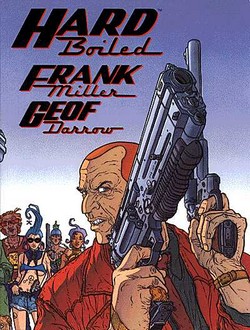|
|
 |
HARD BOILED
DARK HORSE COMICS
WRITER: Frank Miller
ARTIST: Geof Darrow
COLORIST: Claude Legris
ISBN: 9781878574589; paperback
128 pp., Color, $16.95
When Dark Horse Comics announced sometime in 1988 that they would be publishing Frank Miller’s next original projects, the young company was signaling that they were for real. In the end, Miller produced the Martha Washington series with Dave Gibbons on art and also Hard Boiled with Geof Darrow as artist.
Hard Boiled was a three-issue mini-series published in a magazine-sized format, and was later collected in 1993 in a trade format. This comic was apparently loosely based on a Philip K. Dick story and followed a man named Nixon, a tax collector who occasionally struggles with memory and identity issues. He really is an unstoppable cyborg/robot assassin for a home appliance company, and he goes on a rampage to get answers.
THE LOWDOWN: At the time of release, some considered Hard Boiled the most violent comic book ever published (at least to the people who’d never seen Robt. Williams and S. Clay Wilson’s mind-numbing, troubling comix). Besides PKD, there are similarities to anime and manga ( Akira), Howard Chaykin’s American Flagg!, Harlan Ellison (specifically “Demon with a Glass Hand”) and James Cameron’s film, The Terminator, which was… influenced by Ellison’s work.
Hard Boiled doesn’t have much of a story on the surface, but I don’t think Frank Miller was necessarily interested in some kind of sustained narrative here. It’s about collaboration, a joint venture between a writer and an artist – in a time when many artists started believing that they didn’t need writers. Some writer/artists were comparing themselves to the two dominate writer/artists of the 1980’s mainstream comics – one being Frank Miller and the other being John Byrne. (Most didn’t have Miller’s brash willingness and need to experiment or Byrne’s fidelity to vocation and extensive knowledge of the characters upon which he worked, but that’s another story.) At this time, Miller was looking to work with artists whom he admired, while other artists were declaring their independence and lacking either the talent or work ethic to be writer/artists or cartoonists. So Hard Boiled may have been the first hip hop comic – the “collabo.”
We know the brilliance of Miller – his ability to create vital, striking images that encapsulate his ideas of superhero comics as romantic adventures. Honestly, he can take a 22-page comic story and half the pages are filled with panels or full page spreads that take your breath away. He can frustrate and infuriate, but he can also take the reader to the heights of ecstasy and tumult. Homie don’t do lame or play it safe.
The surprising thing here is that Miller could act only as the writer and structure a story for another artist, in this case, Geof Darrow, that would allow the artist to create intoxicating and arresting visuals. Darrow’s design for the series is retro sci-fi with a strong emphasis on art deco (even for the automobiles and vehicles, which creates some weird looking rides). Darrow builds each panel, each scene, and every page with a meticulous level of detail that gives Miller’s straight-forward narrative a sense of complexity. In this incredibly intricate artwork, we find what should be the story of a simple middle class man’s life is a web of intrigue that is bigger than him. The ultra-violence and paranoia were part of an exercise to expand the scope of comic book visuals. It’s as if they were reminding people of Jack Kirby, especially since after him, so many artists were content to constrain the energy and wildness of superhero comics.
So the genius of Miller is that he created a comic in which another artist could create a visual landscape every bit as staggering as his own, and that’s saying a lot considering what Miller had shown us up to that point in time.
FOR READERS OF: Anyone who believes that he or she is capable of holding a serious conversation about the art of comics has to have read this. Otherwise, any adult reader who wants to see great work will want this.
© Copyright 2002-2019 by Toon Doctor Inc. - All rights Reserved. All other texts, images, characters and trademarks are copyright their respective owners. Use of material in this document (including reproduction, modification, distribution, electronic transmission or republication) without prior written permission is strictly prohibited.

